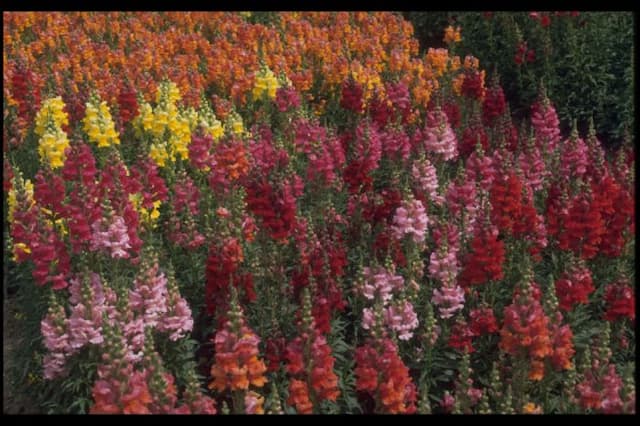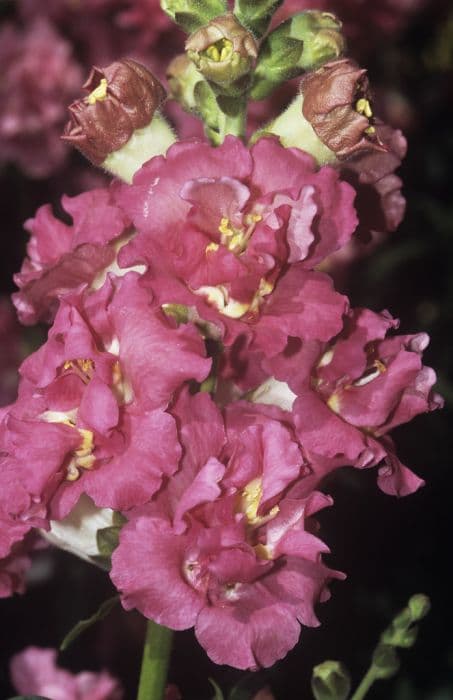Hebe Hebe 'Margret'

ABOUT
Hebe 'Margret' is a visually striking plant known for its decorative foliage and flowers. The plant typically has glossy, dark green leaves that create a dense, bushy appearance. These leaves are oval-shaped with a slightly pointed tip and are arranged in a paired fashion along the stems. During the blooming season, Hebe 'Margret' produces an abundance of flowers that can range in color from pale lilac to deep purples, which stand out against the dark foliage. The flowers are small, with a tubular shape and are clustered together in dense, spike-like formations that rise above the foliage, giving the plant an added allure. These blooms are particularly attractive to bees and butterflies, adding to the plant's charm and its role in supporting local ecosystems. Overall, Hebe 'Margret' is a plant with year-round interest thanks to its evergreen nature and the seasonal color provided by its delightful blooms.
About this plant
 Names
NamesFamily
Plantaginaceae
Synonyms
Shrubby Veronica, Veronica
Common names
Hebe 'Margret'
 Toxicity
ToxicityTo humans
Hebe 'Margret', more commonly known simply as Hebe, is not known to be highly toxic to humans. There is limited information on the toxicity of Hebe to humans, and it is generally considered non-toxic. However, it's always prudent to avoid ingesting plants that are not known to be edible as they can cause gastrointestinal discomfort or allergic reactions in some individuals. If any part of the plant is ingested and symptoms such as nausea, vomiting, or diarrhea occur, medical advice should be sought.
To pets
Hebe 'Margret', or Hebe, is not known to be highly toxic to pets. Toxicity in pets such as dogs and cats is typically low, and Hebe is not listed on common toxic plant lists for pets. However, some pets may have sensitivity or allergic reactions to plants that are not generally considered poisonous. If a pet ingests a significant quantity of Hebe and exhibits symptoms such as vomiting, diarrhea, or signs of distress, it is advisable to contact a veterinarian.
 Characteristics
CharacteristicsLife cycle
Perennials
Foliage type
Evergreen
Color of leaves
Green
Flower color
Purple
Height
3 feet (0.91 meters)
Spread
3 feet (0.91 meters)
Plant type
Shrub
Hardiness zones
8
Native area
New Zealand
Benefits
 General Benefits
General Benefits- Easy to Grow: Hebe 'Margret' is known for being hardy and easy to care for, making it a good choice for gardeners of all skill levels.
- Ornamental Appeal: With its attractive foliage and pretty flowers, it adds aesthetic value to gardens and landscapes.
- Attracts Wildlife: The flowers of Hebe 'Margret' can attract bees, butterflies, and other beneficial pollinators, promoting biodiversity.
- Long Flowering Period: It has a long blooming season, which can provide color and interest in the garden for an extended time.
- Drought Tolerance: Once established, Hebe 'Margret' can tolerate periods of drought, making it suitable for xeriscaping and water-conserving gardens.
- Compact Size: Its generally compact growth habit makes it suitable for smaller gardens or growing in containers.
- Versatility: It can be used in a variety of garden settings, such as borders, rockeries, and coastal gardens due to its tolerance for different conditions.
 Medical Properties
Medical PropertiesThis plant is not used for medical purposes.
 Air-purifying Qualities
Air-purifying QualitiesThis plant is not specifically known for air purifying qualities.
 Other Uses
Other Uses- Artistic inspiration: Hebe 'Margret' can provide a rich source of inspiration for artists and illustrators due to its vibrant color and delicate form, often featuring in botanical art and nature sketches.
- Natural food dye: The flowers and leaves may potentially be used as a natural dye in culinary presentation, though specific use should be researched to ensure safety.
- Garden photography: As a visually attractive plant, Hebe 'Margret' can be used as a subject for garden and plant photography, helping hobbyists and professionals alike to hone their photographic skills.
- Educational tool: This plant can be used in schools or educational programs to teach students about horticulture, plant biology, and the importance of biodiversity.
- Crafting: Dried flowers can be incorporated into crafts, such as making bookmarks, pressed flower art, or adding an ornamental touch to handmade paper.
- Floral arrangements: Fresh or dried Hebe 'Margret' can contribute unique texture and color to floral arrangements and bouquets.
- Erosion control: When planted in groups, the Hebe 'Margret' can help stabilize soil in areas prone to erosion due to its root system.
- Fairy gardens: This variety of Hebe provides an ideal plant choice for creating whimsical fairy gardens due to its compact size and attractive foliage.
- Wildlife habitat: Hebe 'Margret' can be included in wildlife gardens to attract and provide habitat for beneficial insects, including bees and butterflies.
- Living gifts: These plants can be offered as living, sustainable gifts for gardeners or plant enthusiasts instead of cut flowers.
Interesting Facts
 Feng Shui
Feng ShuiThe Hebe plant is not used in Feng Shui practice.
 Zodiac Sign Compitability
Zodiac Sign CompitabilityThe Hebe plant is not used in astrology practice.
 Plant Symbolism
Plant Symbolism- Youth and Vigor: The name "Hebe" comes from Greek mythology, where Hebe is the goddess of youth. Thus, the plant is often associated with the freshness and vitality of youth.
- Eternal Love: With its evergreen leaves, Hebe symbolizes constancy and enduring affection, making it a plant that can represent lasting relationships.
- Unity: The dense and cohesive growth habit of Hebe plants can symbolize unity and solidarity within a group or family.
- Protection: In some traditions, Hebe plants are believed to offer protection, representing a sheltering presence in gardens or homes.
 Water
WaterThe Hebe, commonly known as Veronica, requires watering when the top inch of soil feels dry to the touch. It is essential to water the plant thoroughly, allowing excess water to drain out of the bottom of the pot to avoid waterlogging. Generally, this might mean watering once a week, but the frequency can vary depending on environmental conditions such as temperature and humidity. Aim to provide the Veronica with about one gallon of water every week during the growing season, reducing the amount during the dormant winter months.
 Light
LightThe Veronica prefers a spot where it can receive full to partial sunlight for the majority of the day. The ideal location would offer morning sunlight and some shade from the intense afternoon rays, as too much direct sunlight can be harmful. An east or west-facing window is typically a good fit for indoor plants, or a partially shaded spot in the garden for outdoor Veronicas.
 Temperature
TemperatureVeronicas thrive in temperatures ranging from 50°F to 72°F, which are their ideal growing conditions. They can tolerate a minimum temperature of about 30°F but should be protected from frost. On the higher end, temperatures above 80°F might stress the plant, so it is important to provide some shade and increased humidity during hot weather.
 Pruning
PruningPrune the Veronica to maintain its shape, encourage bushy growth, and remove any dead or damaged stems. The best time for pruning is in spring or after the plant has finished flowering. Lightly trimming the plant back by a few inches every year helps to stimulate new growth and maintain an attractive appearance.
 Cleaning
CleaningAs needed
 Soil
SoilThe best soil mix for Hebe 'Margret' should be well-drained with a slightly acidic to neutral pH, ideally between 6.5 and 7.5. A blend of two-thirds garden soil and one-third coarse sand or perlite can support good drainage and root health. Adding organic matter like compost or peat moss will further enhance soil structure and provide necessary nutrients.
 Repotting
RepottingHebe 'Margret', also commonly known as Shrubby Veronica, should be repotted every two to three years to refresh the soil and allow room for growth. Younger plants may require more frequent repotting if they are outgrowing their current containers.
 Humidity & Misting
Humidity & MistingHebe 'Margret' thrives in moderate humidity conditions and does not require excessively high humidity levels. Ensuring good air circulation can help maintain appropriate humidity around the plant.
 Suitable locations
Suitable locationsIndoor
Provide bright, indirect light and avoid overwatering.
Outdoor
Plant in sunny to partly shaded spots, sheltered from harsh winds.
Hardiness zone
7-10 USDA
 Life cycle
Life cycleThe Hebe 'Margret', commonly known as Shrubby Veronica, begins its life cycle with germination, where the seeds sprout in spring to early summer under appropriate conditions of warmth and moisture. Seedling development follows, characterized by the growth of the first true leaves, at this stage the young plant is establishing its root system and becoming more resilient. As it matures into a juvenile plant, the Hebe 'Margret' develops a more pronounced woody structure and foliage, with its distinctive leaves becoming more abundant. The adult stage is marked by the plant's readiness to flower, typically from early summer to fall, showcasing its small but abundant purple, white, or pink flowers that attract pollinators. After pollination, seeds are produced, which will be dispersed by wind or wildlife to start new plants. Eventually, as the Hebe 'Margret' ages, it enters senescence, where growth slows, and the plant may die back, particularly if faced with harsh winter conditions or disease.
 Propogation
PropogationPropogation time
Spring-Early Summer
The Hebe 'Margret', often referred to simply as Hebe, can be propagated through semi-hardwood cuttings. The best time to take these cuttings for propagation is in late summer or early autumn. To propagate, select a healthy, disease-free branch and make a cut to obtain a piece about 4 to 6 inches (10 to 15 centimeters) long. Remove the lower leaves and dip the cut end in rooting hormone for better chances of success. Then insert the cutting into a pot filled with a mixture of peat and perlite or coarse sand to provide good drainage. The cutting should be placed in a warm, bright area but not in direct sunlight. Maintain consistent moisture in the soil without saturating it, and with appropriate care, the cutting should root within a few weeks.





![Snapdragon [Pretty in Pink]](/_next/image?url=https%3A%2F%2Fplants-admin.emdemapps.com%2Fimages%2Fplants%2F%2Fimages%2F604b5cb3b5385.png&w=640&q=75)



